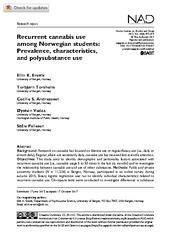| dc.contributor.author | Erevik, Eilin K. | |
| dc.contributor.author | Torsheim, Torbjørn | |
| dc.contributor.author | Andreassen, Cecilie Schou | |
| dc.contributor.author | Vedaa, Øystein | |
| dc.contributor.author | Pallesen, Ståle | |
| dc.date.accessioned | 2018-04-20T12:44:23Z | |
| dc.date.available | 2018-04-20T12:44:23Z | |
| dc.date.issued | 2017 | |
| dc.Published | Erevik Eilin K., Torsheim T, Andreassen CS, Vedaa Ø, Pallesen S. Recurrent cannabis use among Norwegian students: Prevalence, characteristics, and polysubstance use. Nordic Studies on Alcohol and Drugs. 2017;34(6):497-510 | eng |
| dc.identifier.issn | 1458-6126 | |
| dc.identifier.issn | 1455-0725 | |
| dc.identifier.uri | https://hdl.handle.net/1956/17631 | |
| dc.description.abstract | Background: Research on cannabis has focused on lifetime use or regular/heavy use (i.e., daily or almost daily). Regular, albeit not necessarily daily, cannabis use has received less scientific attention. Objectives: This study aims to identify demographic and personality factors associated with recurrent cannabis use (i.e., cannabis usage 5 to 50 times in the last six months) and to investigate the relationship between cannabis use and use of other substances. Methods: Public and private university students (N = 11,236) in Bergen, Norway, participated in an online survey during autumn 2015. Binary logistic regression was run to identify individual characteristics related to recurrent cannabis use. Chi-square tests were conducted to investigate differences in substance use (alcohol, nicotine, and illicit drugs) between recurrent cannabis users and cannabis abstainers/low-frequency users. Results: A total of 4.0% of the students reported recurrent cannabis use. Students born in North America, non-Christians (compared to non-religious students), and men were more likely to be recurrent users. Recurrent cannabis users scored higher on extroversion and intellect/imagination compared to abstainers/low-frequency users. Male and female recurrent cannabis users had somewhat different characteristics (e.g., agreeableness scores were negatively associated with recurrent use among females but not among males). Recurrent cannabis use was overall strongly associated with polysubstance use. Conclusions: The prevalence of recurrent cannabis use among Norwegian students is low. Recurrent cannabis use seems more prevalent among individuals marked by extroversion and intellect/imagination, which supports the notion of cannabis use as a social activity for individuals identifying themselves as outgoing and unconventional. Cannabis use among students seems strongly associated with use of other substances, suggesting that cannabis should not be considered a replacement drug. | en_US |
| dc.language.iso | eng | eng |
| dc.publisher | SAGE | eng |
| dc.relation.uri | http://journals.sagepub.com/doi/pdf/10.1177/1455072517743427 | |
| dc.rights | Attribution CC BY-NC | eng |
| dc.rights.uri | http://creativecommons.org/licenses/by-nc/4.0/ | eng |
| dc.subject | alcohol | eng |
| dc.subject | cannabis | eng |
| dc.subject | drug use | eng |
| dc.subject | hashish | eng |
| dc.subject | marijuana | eng |
| dc.subject | nicotine | eng |
| dc.subject | personality | eng |
| dc.subject | polysubstance use | eng |
| dc.subject | students | eng |
| dc.title | Recurrent cannabis use among Norwegian students: Prevalence, characteristics, and polysubstance use | eng |
| dc.type | Peer reviewed | |
| dc.type | Journal article | |
| dc.date.updated | 2018-02-01T10:45:12Z | |
| dc.description.version | publishedVersion | |
| dc.rights.holder | Copyright 2017 The Author(s) | eng |
| dc.identifier.doi | https://doi.org/10.1177/1455072517743427 | |
| dc.identifier.cristin | 1516853 | |
| dc.source.journal | Nordic Studies on Alcohol and Drugs | |

